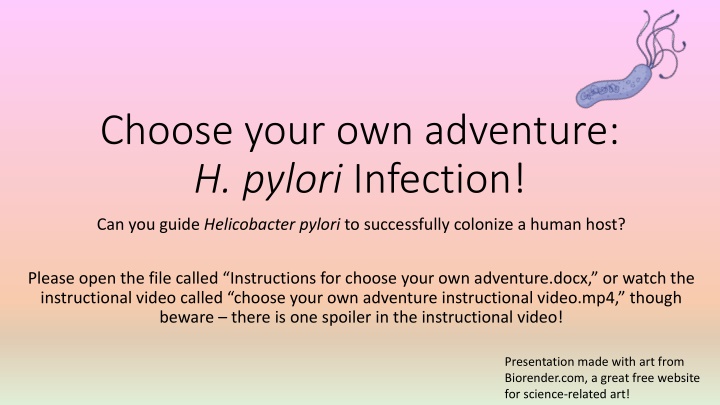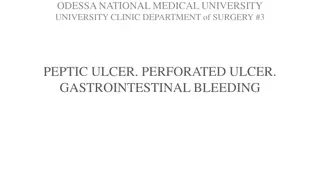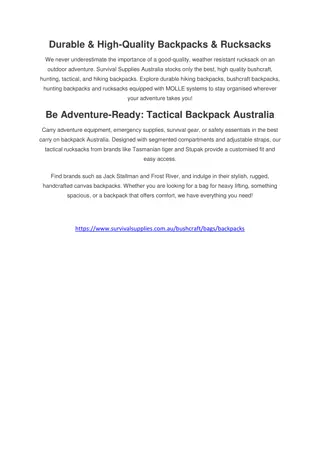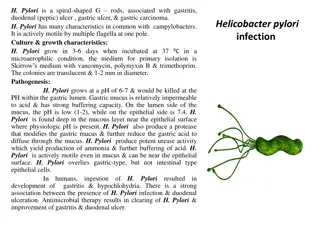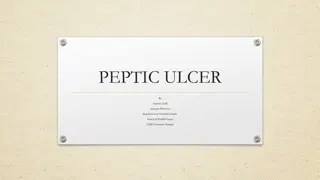Guiding H. pylori Infection: A Choose Your Own Adventure Journey
Can you navigate Helicobacter pylori to successfully infect a human host? Embark on an adventure to understand how H. pylori colonizes humans, starting from the stomach. Explore the intricate process through interactive choices and engaging activities. Discover the fascinating world of microbial infections and test your skills in guiding this cunning bacteria to achieve its goal.
Download Presentation

Please find below an Image/Link to download the presentation.
The content on the website is provided AS IS for your information and personal use only. It may not be sold, licensed, or shared on other websites without obtaining consent from the author.If you encounter any issues during the download, it is possible that the publisher has removed the file from their server.
You are allowed to download the files provided on this website for personal or commercial use, subject to the condition that they are used lawfully. All files are the property of their respective owners.
The content on the website is provided AS IS for your information and personal use only. It may not be sold, licensed, or shared on other websites without obtaining consent from the author.
E N D
Presentation Transcript
Choose your own adventure: H. pylori Infection! Can you guide Helicobacter pylori to successfully colonize a human host? Please open the file called Instructions for choose your own adventure.docx, or watch the instructional video called choose your own adventure instructional video.mp4, though beware there is one spoiler in the instructional video! Presentation made with art from Biorender.com, a great free website for science-related art!
H. pylori infects about half of humans in the world! This bacteria has gotten very good at infecting humans. Do you think you could infect a human if you were H. pylori? The first step is knowing where to go. Where do you think H. pylori infects humans? Hint! Hint! A close up of a piece of paper Description automatically generated A close up of a piece of paper Description automatically generated A close up of a piece of paper Description automatically generated A close up of a logo Description automatically generated A cut on your hand! The Stomach! The Brain! The Eye!
Go back! Go back! Hint: We can t see an H. pylori infection unless we look inside of the body!
Try Again! Try Again! Incorrect. But, some microbes can infect the brain! Aspergilli (a type of fungus), Toxoplasma gondii (a type of protozoan), and Taneia solium (a parasite) can all infect the brain!
Try Again! Try Again! Incorrect. But, some microbes can infect the eye! Bacteria, such as Staphylococcus aureus and Pseudomonas aeruginosa, viruses such as the herpes simplex virus and adenoviruses (which cause the common cold), and many more microbes, can all infect the eye!
Try Again! Try Again! Incorrect. But, there are many bacteria that can infect a cut on your skin. We all have millions of bacteria living on our skin. In fact, your skin provides a great physical barrier to any bacteria that are living on it, so that they can t get into your body! That is why it s very important to wash a cut right after you get injured so that it doesn t get infected.
Next! Next! Correct! H. pylori does infect the stomach! Let s do an activity with what you ve learned! This activity will give us a map so that we can see the rest of the infection process. Let s make a shadow box! Please open the instructional video file called Shadow box instructional video.mp4. If you d like to print shadow box components instead of making your own, please open the file called Shadow box components.docx.
Once H. pylori makes it to the stomach, it has to fight back against our stomach's natural defenses. What is the first thing you need to do? A picture containing room Description automatically generated Hint! A close up of a piece of paper Description automatically generated A close up of a piece of paper Description automatically generated Just keep swimming A close up of a piece of paper Description automatically generated Turn on defenses against acid Turn on defenses against host security guard cells Turn on defenses against harmful oxygen
Go back! Go back! Hint: How does our stomach protect itself from unwanted microbes? What would H. pylori have to do to protect itself from the defenses of the stomach?
Try Again! Try Again! Incorrect. It will be important later for H. pylori to turn on its defenses against the human security guard cells that raise the alarm and fight back against intruders, but right now the security guard cells would have a hard time sensing the H. pylori swimming around freely in the stomach. There s something else we need to do first!
Try Again! Try Again! Incorrect. Most harmful oxygen species are made by host cells as a way to injure the bacteria and make it harder for the bacteria to survive. Our H. pylori isn t in contact with human cells yet, so there isn t a lot of harmful oxygen to worry about right now.
Try Again! Try Again! Incorrect. H. pylori s ability to swim using its flagella (the noodle-looking appendages coming off on one side) are essential for setting up a chronic (long-term) infection. But, there s something we have to do first so that we can survive the harsh environment of the stomach!
Next! Next! Correct! One of the main ways that the stomach protects itself (and you) from unwanted microbes is by making lots of acid. In addition to killing of millions of unwanted microbes, this acid also helps us digest our food!
Great! You've made it to the thick, protective layer of mucus (ew!) that shields our stomach cells from the harmful effects of stomach acid. Hint! A picture containing room Description automatically generated What should you do here? A picture containing room Description automatically generated A picture containing room Description automatically generated A close up of a piece of paper Description automatically generated Settle in. This is a pretty cool place. Turn on foraging equipment to gather resources. Turn on defenses against harmful oxygen. Just keep swimming.
Go back! Go back! Hint: Which of these could help you move through the mucus layer?
Try Again! Try Again! Incorrect. Most harmful oxygen species are made by host cells as a way to injure the bacteria and make it harder for the bacteria to survive. Our H. pylori isn t in contact with human cells yet, so there isn t a lot of harmful oxygen to worry about right now. To get in contact with human cells, we have to make it through the mucus layer!
Try Again! Try Again! Incorrect. Here, we re still surrounded by stomach acid, and there aren t many nutrients we can get to help us keep growing and divide to make more bacteria! There will be lots of good nutrients with the human cells on the other side of this mucus layer.
Try Again! Try Again! Incorrect. H. pylori waits for a specific signal from host cells to activate its pathogenic machine for secretion, and we re not in contact with host cells yet.
Correct! H. pylori has a very specific shape that helps it get through the thick layer of mucus. H. pylori is spiral- shaped, which means it makes a corkscrew shape as it swims this helps it push through the protective mucus and make it to the other side. Do you think you could push through a thick layer of mucus if you were a bacteria? What shape do you think would make it easiest to get through? Let s do an activity, Swim through Mucous, to find out! Next! Next! Please open the file called Instructions for swim through mucous.docx, or if you want to see an instructional video instead, open the file called Swim through mucous instructional video.mp4. If you want to see examples of this experiment, open the file Swim through mucous example.jpg
Good job, you made it through the mucus and you're right next to the host cells, protected from the stomach acid by the mucus layer you just swam through. Now, you need to settle in and set up a chronic (long- term) infection in this nice spot. Hint! A picture containing room Description automatically generated What do you do? A close up of a piece of paper A close up of a piece of paper Description automatically generated A picture containing room Description automatically generated Description automatically generated A picture containing room Description automatically generated A picture containing room Description automatically generated A picture containing room Description automatically generated Settle in and start dividing to make more bacteria! Turn on defenses against harmful oxygen! Turn on foraging equipment to gather resources! Turn on defenses against host security guard cells!
Go back! Go back! Hint: There is more than one correct answer! H. pylori has a lot to do to set up a successful long-term infection!
Learn More! Learn More! Correct! H. pylori can do multiple things to avoid being seen by the host security guard immune cells, like changing how it looks on the outside to make it harder to recognize. By changing its antigens, which are proteins that the immune system cells recognize, it s like changing the hair color and style on a human it would take you longer to realize who that person is, and you might not recognize them at all! But, H. pylori is even more interesting than that! Sometimes, H. pylori does things to make it more recognizable to the immune system, like secreting bacterial factors (such as DNA) that are easy for the immune system to recognize. Some scientists think H. pylori might do this to make the immune system respond with inflammation, which makes it much harder for other bacteria to continue living in the stomach. That would make more room for H. pylori.
Learn More! Learn More! Correct! H. pylori sets up small pockets of bacteria to live together in the stomach and keep other bacteria from coming to live near their epithelial cells. It s similar to how we might set up a campsite, and keep other people or animals from coming too near our s mores ingredients or tents.
Learn More! Learn More! Correct! H. pylori has several defenses against harmful oxygen (also known as reactive oxygen species, or ROS for short). ROS can harm H. pylori s DNA, which is the blueprint H. pylori needs to make more of itself. To protect its DNA blueprint, H. pylori uses enzymes like catalase to break down the ROS into something that isn t as harmful. Let s do an activity to learn more about ROS by making Elephant Toothpaste! Please open the file called Instructions for Elephant Toothpaste.docx. If you want to see an example of this experiment, open the file called Elephant Toothpaste Example Video.mp4
Learn More! Learn More! Correct! H. pylori has many machines that help it get stuff from and add stuff to the host environment. These machines are called secretion systems (there s a picture of one on this slide). The secretion systems do really cool and essential work! For example, one of H. pylori s secretion systems helps it pick up DNA (blueprints) from the environment so the bacteria can update its own blueprints. Another secretion system allows H. pylori to shoot bacterial factors, like its own DNA or a harmful protein called CagA, into the host environment. Do you think you could use a secretion system to shoot stuff into the environment safely? Let s make our own secretion system Rubber Band Cannon and see! Please open the files called Rubber band cannon cutout.docx and Instructions for rubber band cannon.docx. If you want to see an example of this experiment, please open the files Rubber band cannon example video 1.mp4 or Rubber band cannon example video 2.mp4
